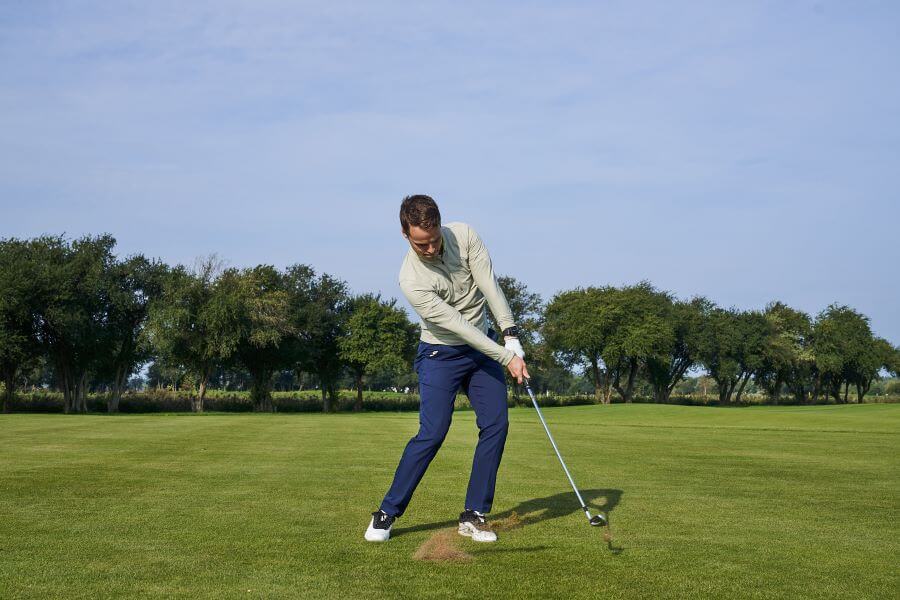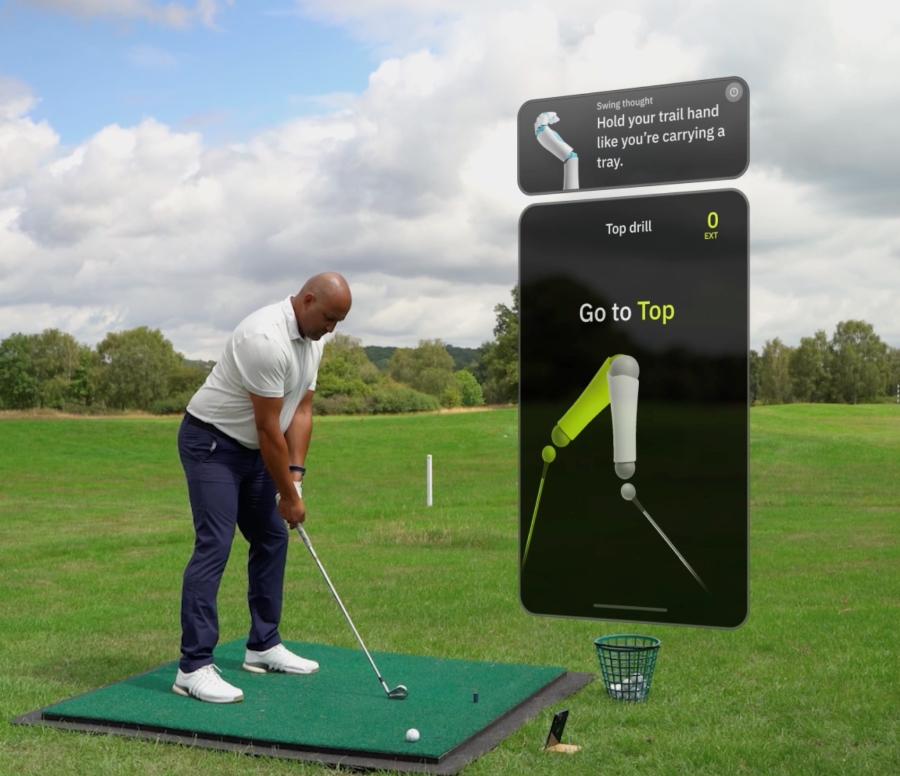Golf Swing Tempo: How to Improve Rhythm with Tips & Drills
Do you feel like every time you try to “fix” your golf swing tempo, it only makes things worse? You aren’t alone.
Many golfers confuse tempo with swing speed. Some slow everything down, only to lose power. Others swing fast but lose rhythm and balance.
The key is understanding that tempo is about the relationship between your backswing and downswing, and it can be practiced.
With the right drills and tools, you can learn how to swing with rhythm, improve sequencing, and finally make your tempo consistent.
Golf Swing Tempo (Key Takeaways)
Here are the most important things to remember about golf swing tempo:
- Golf swing tempo is about timing, not how fast you swing. The ideal full-swing tempo is a 3:1 ratio (backswing to downswing).
- Slowing your swing down won’t fix tempo. Sequencing and rhythm are what matter most.
- HackMotion lets you measure tempo on every swing so you can see if your rhythm matches pro-level patterns.
- Poor tempo is often caused by tension, static setups, or “snatching” the club away at takeaway.
- You can practice tempo directly. Drills like the Step Drill and Line Up Drill make it repeatable.
Prefer watching instead of reading? Check out Rob Cheney’s swing tempo video below.
Contents
What is Golf Swing Tempo?
Tempo is the timing of your swing, not just how fast you move the club. It’s the duration of the backswing compared to the downswing.
- On a full swing, elite players typically take three times longer going back than they do coming down. That’s a 3:1 ratio.
- In the short game, tempo is closer to 2:1.
- Consistent tempo makes a swing look smooth and effortless, even when it’s powerful.
If your backswing is too quick or your downswing drags, the ratio gets off balance. That’s when timing issues and mishits creep in.
Why Tempo Matters
Tempo influences every part of ball striking, from power to control. A rushed downswing dumps energy before impact and causes a weak strike. In addition, inconsistent tempo makes it hard to square the clubface at impact.
When your tempo is great it’s easier to have better balance and consistency in your game.
Think of tempo as the glue that ties mechanics, sequencing, and timing together.
What Causes Bad Tempo?
Some golfers will tell you that tempo feels like it can change from one day to the next. While that may be true, there are usually some underlying causes that could throw off your tempo. These include:
- Static setup – Standing frozen over the ball often leads to a jerky takeaway.
- Too much grip tension – Tight hands and arms make the swing rigid.
- Over-controlling backswing – Going painfully slow or snatching the club away ruins sequencing.
- One-club practice – Hitting only drivers at the range makes rhythm inconsistent.
These issues all show up clearly in HackMotion data. If your ratio is more like 2:1 or 4:1 instead of 3:1, your swing may look fine, but the results won’t be.
Is Tempo Natural or Learned?
Some golfers believe tempo is just “natural,” but that’s only part of the story. Yes, certain players have a naturally smooth rhythm, but even the best spend hours training it.
Tempo can be practiced:
- HackMotion measures your ratio after every swing so you know if you’re in range.
- Feedback helps you feel the right rhythm instead of guessing.
- With drills and repetition, your body learns to repeat the same sequence without conscious thought.
Drills to Improve Golf Swing Tempo
These three drills, taken from our HackMotion Tempo Training video, are designed to help you build rhythm, balance, and sequencing.
Each drill is easy to set up, but the real benefit comes from pairing it with HackMotion feedback so you can see whether your tempo is in range.
Setup Position Drill
One of the biggest mistakes golfers make is standing completely still and locked in at address.
This static setup often leads to snatching the club back too quickly or moving out of sequence. The best players stay relaxed, with small motions that help them start the swing in rhythm.
Setup Position Drill – Step by Step
- Address the ball with slight movement, like a waggle of the club and soft foot action. Avoid locking yourself into a frozen, rigid stance.
- Swing and hold your finish until the ball lands.
- If you can’t balance at the finish, your tempo is off.
This drill teaches you to stay dynamic, not static, so the takeaway flows instead of jerks. Holding the finish is a built-in tempo check; if you’re rushing, you won’t stay balanced.
Step Drill
Golfers with poor tempo often disconnect their upper and lower body. The Step Drill forces the body to move in sequence, creating flow instead of a rushed or rigid swing.
It’s a favorite of coaches because it exaggerates the feeling of rhythm and helps you “time” the backswing and downswing naturally.
Step Drill – Step by Step
- Start with your feet together, club hovering just in front of the ball.
- Push the club slightly forward as your trail foot steps back.
- As the club starts its backswing, step your lead foot forward.
- Swing through smoothly and hold your finish.
At first, this drill can feel awkward, but once you coordinate the steps, the swing feels effortless.
HackMotion will show how your tempo ratio stabilizes because your body and club are moving in sync.
Line Up Drill
This classic drill is all about keeping the swing in motion. Many golfers reset between every shot, which can encourage a stop-start rhythm.
Lining up several balls forces you to maintain flow and trust your sequencing. It’s one of the simplest ways to feel what “continuous tempo” is supposed to be.
Line Up Drill – Step by Step
- Place 4–5 balls in a row, spaced slightly apart.
- Start swinging and strike the first ball without pausing.
- Continue into the next ball, keeping the club moving the whole time.
- Repeat until all balls are struck, then hold your balanced finish.
The goal isn’t perfect shots but smooth, uninterrupted rhythm. By the time you reach the last ball, you should feel the swing carrying itself with very little extra effort.
FAQs
What’s the perfect tempo?
Most pros use a 3:1 ratio on full swings and closer to 2:1 in the short game.
Does tempo affect distance?
Yes. Poor tempo leads to energy leaks and less clubhead speed at impact.
Do all clubs have the same tempo?
Yes, as long as you’re making a full swing. The driver and the 7-iron should have the same tempo. When you start taking shorter swings, the tempo may vary.
Final Thoughts
Tempo isn’t about swinging slower. It’s about swinging with rhythm, balance, and repeatability.
By starting dynamically, maintaining your finish, and utilizing drills such as the Step Drill and Line Up Drill, you can develop tempo as one of your key strengths.
HackMotion simplifies this process by measuring your exact swing ratio and providing instant feedback. That way, you’re not guessing whether your tempo is good; you’ll know.













